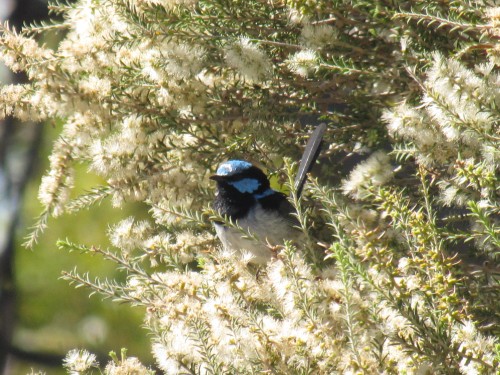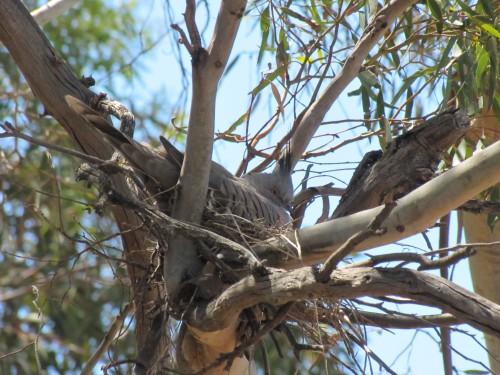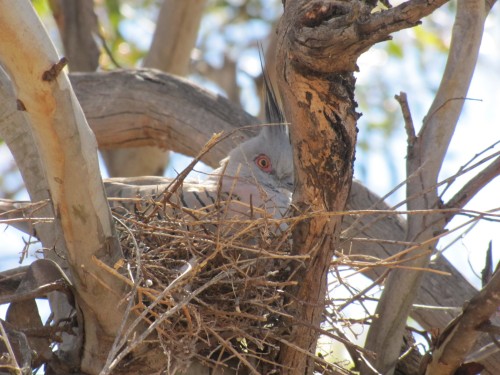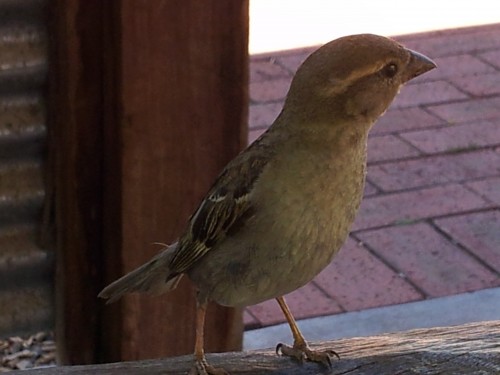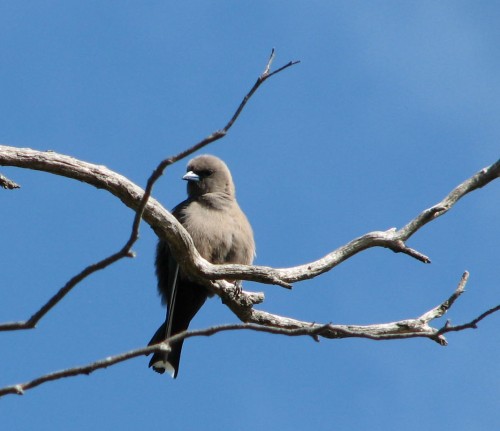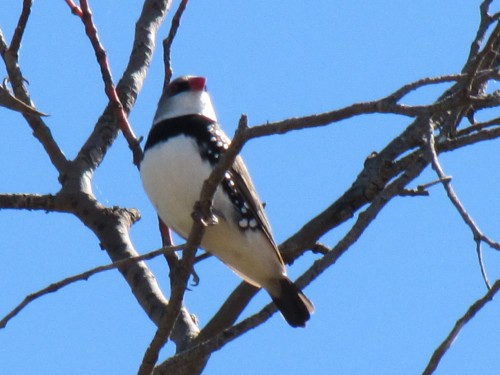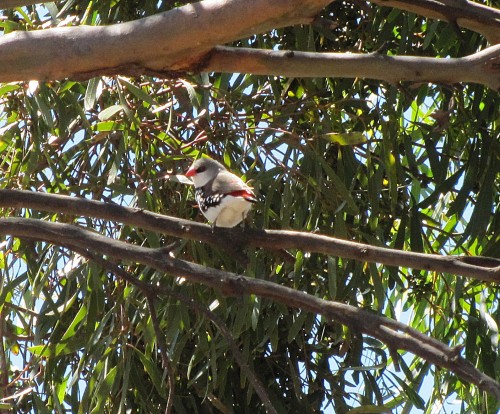Wrens at the birdbath
This morning my wife and I were in the sun room enjoying breakfast when a family of Superb Fairy-wrens came to the bird bath just outside the window. There was one male and two uncoloured birds, probably both females. This was delightful because we hadn’t seen or heard them in the garden for well over a week.
They stayed long enough to have a drink and a short splash in the water. It wasn’t long enough to get any photos, so I have used a photo taken some time ago. The photo above was also taken in our garden a few months ago, so it it almost certain it is the same bird as the one we saw this morning.
Crested Pigeons nesting in our garden
On our return from a recent holiday in Sydney we were having lunch on the back veranda. I was watching a Crested Pigeon fussing about in a tree about twenty metres away. Next thing it settled down as if on a nest. I left my food – actually I think I was at the cuppa stage of the meal – and moved slowly and carefully towards the nest. I’d remembered to go inside to get my camera first.
Sure enough – the pigeon was sitting on a nest. Crested Pigeons are very common around Murray Bridge. At times I have counted up to 50 sitting perched on power lines, often in a row. It’s quite a spectacular sight, though it is not common to see so many at one location. Loose groups of 5 to 15 are quite common, however.
Crested Pigeons are what I call a resident breeding species, meaning, they are resident all the year and that they breed in our garden. The nest shown in today’s photos is quite a substantial nest for a pigeon. Most pigeons and doves are not fastidious or elaborate when it comes to nest building. They seem to think that a dozen or so flimsy sticks placed at random in the fork of any tree or bush will do as a home for their chicks. How the eggs don’t fall through some nests I’ve seen is amazing. Still, they seem to manage; there are a lot of them around!
My writing of this post was interrupted by the load of washing finishing, and I am the one in our household who usually does the washing. The pigeon’s nest is near the clothes line and the bird is sitting tight, even when we walk within a few metres of the nest. She must have eggs, I think. I will keep a watch on proceedings.
UPDATE: January 22nd: over the last week we have had a heatwave with five days over 42C with several over 45C (113F). This was followed by several days of wild wind which broke several branches off our trees. The nest is still there but appears to have been abandoned.
On the road again
We are on the road again. To be more precise: we have been on the road and are now in Sydney for about a month staying with family for Christmas. We left just over a week ago and travelled from home in Murray Bridge, South Australia, to my son’s home in Artarmon in two days of many hours in the car. Although the distance is just over 1300km we enjoy the journey, taking note of the changing environments as we go.
All the way we are on the lookout for birds. At certain points along the way we stop for meal breaks, or to refuel. On these occasions I usually jot down the birds observed during our break. Additional lists are sometimes made as we drive along, usually when my wife is driving. If either of us sees something special or out of the ordinary I will make a note of that too.
During the morning of the first day we saw many of the usual species seen along the road from Murray Bridge to Ouyen in Victoria. This is predominantly mallee eucalypt country used for wheat and sheep farming. Along the way we saw several family groups of White-winged Choughs. It always amuses me that they do not merely walk or hop along the ground; it’s more of a swagger. If pressed hard they will fly off, their white wing patches showing up clearly. This easily identifies them from the many Australian Magpies and Little Ravens along this stretch of highway.
Also along this stretch I am also on the lookout for the way the magpies change from the white-backed sub-species to the black-backed. Intermediate hybrids are also worth looking for. As for the ravens it is a harder task. The further east one travels the more Australian Ravens can be found. The only sure way of telling them apart from the Little Ravens is to hear them call, not a practical solution driving at 110kph.
Along this first leg of the journey we also saw a few Grey Currawongs as they glided across the road in front of us, many Willie Wagtails fluttering around in search of breakfast, the occasional Nankeen Kestrel soaring or hovering over the fields, and flocks of Galahs glowing pink in the morning sun. A highlight was several brief sightings of Dusky Woodswallows, always a nice species to see.
Morning tea at Lameroo added Welcome Swallows, Australian Wood Duck, Crested Pigeon and Magpie Lark to the list. I didn’t add the feral domestic ducks which live around the artificial lake.
Coming into Ouyen for lunch I saw the only Brown Falcon sighted on the journey to Sydney. Typically, it was perched on the pole of a telephone line. While having lunch a female House Sparrow cheekily perched on the picnic table about 30cm from my lunch. It was close enough to get a few good shots with my phone (see below).
Other species added to my growing list while we ate lunch included Spiny-cheeked Honeyeater, European Blackbird, Common Starling, Yellow-throated Miner, Singing Honeyeater and White-plumed Honeyeater.
Tomorrow: from Ouyen, Victoria to Narrandera, NSW.
Early morning birding walk
I went for an early morning walk today. It was an enforced walk: I had just taken our car to local garage for a regular service and check up. I could have asked my wife to pick me up in her car but she was still in bed. Despite the early hour, the air was already quite warm and I could understand why most of South Australia has had fire bans issued for the day. Our first burst of hot weather for the summer promises to be a good one. Time to hunker down and do some indoor things. Like reading. Or writing this post.
On my morning walk I was aware of the vast amount of activity on the part of the birds. My walk took exactly 28 minutes to complete and I saw or heard most of the locally resident species along the way, including large numbers of Galahs. The highlight of the walk was two Dusky Woodswallows perched on the fence of a nearby neighbour’s property.
While this species is a regular visitor to our little piece of Australia (5 acres), I can’t call it a resident species. This “pair” of birds – I use the term cautiously – have been sighted on a few occasions in the same spot over the last few weeks. I suspect that they are actually a pair and have a nest nearby. Quite a few years ago a pair nested in one of the trees in our front scrub near our house.
Of course, I didn’t have my camera with me this morning, and my phone camera doesn’t have a zoom sufficient for the job, so I have posted below a photo taken some time ago. This was taken in our scrub near the house.
Diamond Firetail finch, Brown’s Road, Monarto
Diamond Firetails are one of Australia’s more beautiful finches and I am pleased that I can see them within a short distance of my home in Murray Bridge, South Australia. In fact, we have occasionally seen this species in our garden, and on one occasion one even came to one of our bird baths.
Diamond Firetails are widespread in this region without being very common anywhere. In my experience they are usually encountered singly or in a small flock of only a few. The bird in several of the photos today was one of about four we saw at Brown’s Road, Monarto near Murray Bridge several years ago. The photos aren’t brilliant because these birds were rather wary and didn’t allow me to approach too close, even with the 20x zoom on my camera.
